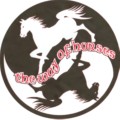
THE WAY OF HORSES |


Copyright © thewayofhorses
Eleanor
Richards |
INTERPRETING
FEED
TAGS By Eleanor Richards Copyright © 2004 |
Juan Valdez is said to be the most influential person in horse nutrition. When I ask a person how much grain are you feeding the answer is, "A coffee can twice a day." Look at your feed tag and find the feeding directions. I'm sure it does not say two coffee cans per day. The most important information on the feed tag is how to feed. The tag will tell you what type of horse the feed is designed for and the amount to feed per head per day. The protein level of the feed is not important if you are feeding the wrong feed and feeding it incorrectly. If you want to feed horses accurately you must invest in a scale and be able to estimate the weight of your horse. A weight tape (often provided by horse feed manufacturers) is accurate enough for computing the estimated weight of your horse. Of course, the most accurate is having him weighed on a large scale…like a truck scale at the local feed mill. Another method is the following formula, which is more accurate than the weight tape. Adult horses: Heart girth measurement in inches, squared (the number multiplied by itself) times his length divided by 330. (The heart girth measurement is taken just behind the elbow, around the barrel, and up over the withers. Keep the tape snug, but not tight. The length measurement is taken from the point of the shoulder blade to the point of the buttocks.) Foals one to 6 weeks of age: Heart girth measurement in inches subtract 25.1 divide by .07 Once you know how much your horse weighs and have a scale take a look at your feed tag. The feeding directions may be general or very detailed. It seems the more detailed feeding directions appear on premium products. The general feeding directions may read: "Feed a mature adult horse 1 to 1.5% of his body weight per day." This means a 1,000 pound horse in this category would require 10 to 15 pounds of the product each day. The more detailed feed tag may have a chart and several feeding programs presented. You will need to determine what the horse's activity level is, find his weight and follow the column down to the amount recommended. So, now that you know how much you should be feeding - in pounds, not "cans" or "scoops" - weigh the feed. You may discover you are not feeding enough...or feeding too much. If you need to increase the amount remember never to feed a 1,000 pound adult horse more than 5 pounds of grain at one meal. Take into consideration the size of the horse. If the horse requires 15 pounds of the product each day, the amount must be divided into 3 to 4 meals. Your horse may be maintaining his weight on the lower amount of feed - even if it is less than the recommended daily feeding rates for his activity level and size. The product and the forage he is receiving are providing the needed calories, but his vitamins and mineral requirements may not be met. If this is the case there are several options. 1. You can continue to feed him the small amount and top dress with a vitamin and mineral supplement. 2. You can find a product that is designed to be fed at low feeding rates. These products are usually premium products - they are highly fortified, easily digested and because of the small amount required - safer to feed. Recycling a coffee can for use as a feed scoop is fine…just know how many pounds it holds. Remember to weigh feed if you change products…a can of feathers and a can of rocks do not weigh the same and products will not be the same either. This is the last article in a series: "How To Read A Feed Tag". Click here to begin the series. This article was taken from the online course "Nutrition For Maximum Performance", taught by Eleanor Richards. For more information Click here. |